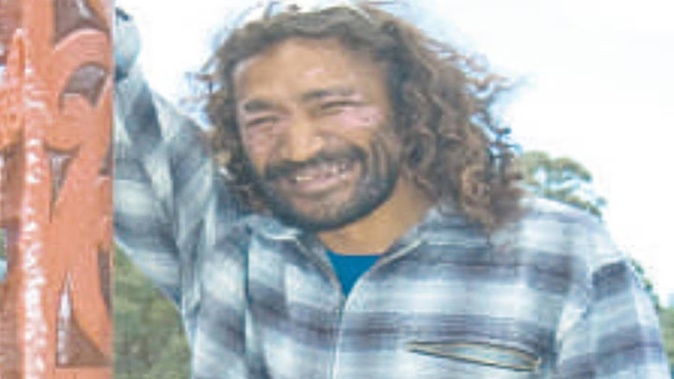
David Kuka was a familiar face in downtown Tauranga, athough shoppers would hear his voice before they saw him.
Tall and rangy, with long dark hair, the 52-year-old would walk the city streets with his fist raised to the sky, pointing to heaven.
Wearing a leather vest with a cross on the back, Kuka would spend his weekend nights busking with his guitar and singing loudly about his saviour.
He was a loud and proud Christian, a gentle soul who cared deeply about others despite falling on hard times.
Kuka was sleeping in his car when he met Stewart Keepa, who was washing dishes at a dinner to feed the homeless in the city.
Keepa ran a second-hand store out of an industrial building in the suburb of Gate Pā, where he lived in a room upstairs.
There was a spare room, too. It wasn’t much but Kuka was grateful for a roof over his head.
In return, Kuka would help around the pawn shop on Wilrose Place. He’d keep the place tidy, and make a little money on the side selling his traditional Maori carvings.
When Keepa came home late on a Sunday evening to find the front door slightly ajar, he instinctively felt something was amiss.
It was February 11, 2018 and Keepa had just ducked out to take his cousin to the supermarket.
Worried that he didn’t have enough gas to make the trip, Keepa had borrowed Kuka’s car, a red Honda, and after dropping his cousin home, arrived back at Wilrose Place shortly after 10pm.
“I heard this horrible breathing, gasping for air, coming from upstairs in the kitchen where I last saw David,” Keepa said.
“I called out his name, but all I could hear was gasping. I ran upstairs and there was David on the floor. I tried to wake him, to see what was wrong, but there was no response … no movement, no talking, nothing.”
David Kuka was lying on the floor, shirtless, in a pool of blood. He had been shot, twice.
A homicide inquiry was soon underway with Detective Sergeant Paul Barron put in charge of solving the puzzle. Investigators often talk about the magic window, the 48 hours after a crime has been committed.
The 50 police staff working on the case moved quickly to gather evidence that might soon be lost: Interviewing key witnesses who frequented Keepa’s store, The Trap, securing text message and call data before it was deleted, as well as security camera footage before files were overwritten.
There was no smoking gun, nothing that immediately identified the killer. There was, however, a lead that was too obvious to ignore.
Someone else had been killed at The Trap just six weeks earlier.
The first victim, Lance Waite, a longstanding member of the Mongrel Mob, was also shot dead.
/cloudfront-ap-southeast-2.images.arcpublishing.com/nzme/6PWRHUBSD3A5NNYEAEIKAGMU7E.jpg)
Lance Waite was fatally shot in January 2018. Photo / Supplied
The shooter was Colin Jeffries-Smith, a low-level dealer of cannabis and sometimes methamphetamine. He was in debt to the tune of $3400, then made the problem worse by taking $2000 in cash from a buyer - but failed to stump up the promised meth.
Debt collection in the drug world involves standover tactics, or “taxing”, where criminals extort cash, drugs or valuables from other criminals in fear of violence or intimidation.
“Taxing” is rarely reported to police, as the victims are in fear of further retribution or exposing their own criminal behaviour.
Waite offered to collect the debt, and “taxed” Jeffries-Smith’s car on December 31, 2017.
Although worth only $800, the silver Nissan Maxima was his most valuable possession.
It was also the only way to keep Jeffries-Smith’s drug business afloat, and any hope of repaying his debt disappeared with it.
The next day, the woman owed $2000, drove the Nissan Maxima to the Cameron Rd home of Jeffries-Smith to demand more money.
He managed to snatch the keys from the ignition and ran away, so Lance Waite arranged for the car to be towed to ‘the Trap’ at Wilrose Place in Gate Pā.
By this point, Jeffries-Smith was getting desperate. He spent most of January 2 negotiating to get his car back, to no avail. He was ready to “start chopping c**** up”, according to a text message he sent. A tomahawk and a knife were later found in a backpack he was carrying.
The small-time drug dealer also visited a man called Casino Williams, who encouraged Jeffries-Smith to “take a stand and shoot the c***”.
Waite was Mongrel Mob, Williams was Black Power. The pair were longtime rivals, both in their 50s, and had bad blood.
Williams handed Jeffries-Smith a semi-automatic Ruger rifle, before he returned to The Trap on the morning of January 3, 2018 in one final bid to bargain for his car.
Lance Waite refused. Jeffries-Smith left and later returned with the loaded weapon. He stood in the doorway of a bedroom, and waited patiently for Waite to leave the room of a woman he was staying with
When the mobster finally appeared in the hallway, Jeffries-Smith pointed the Ruger at him and demanded his car keys.
Again, Waite refused and turned to leave. So Jeffries-Smith shot him. Waite ran down the stairwell to escape, so Jeffries-Smith shot him again, in the back.
The Mongrel Mob member was taken to Tauranga Hospital but soon died of his injuries.
Within a few days, Colin Jeffries-Smith was arrested and charged with murder.
He would later be found guilty of the lesser charge of manslaughter at trial, as the jury accepted he acted in self-defence out of fear of Waite.
/cloudfront-ap-southeast-2.images.arcpublishing.com/nzme/KJF5HLYLKNJ7DSCDPWBXHI6FUQ.jpg)
Colin Richard Jeffries-Smith, left, and Casino Heta Williams appear in the High Court at Rotorua in relation to the murder of Lance Waite at Gate Pa, Tauranga. Photo / NZME
It seemed more than coincidence that two men were killed in the same building, just weeks apart. But what was the connection?
There was absolutely no suggestion that Kuka was involved in Waite’s death.
Although Kuka had once been a member of rival Black Power, that was years ago, and in any event, the police had already arrested Waite’s killer.
There was also no evidence that Kuka was involved in drug dealing at The Trap; just smoking a little bit of weed with Stewart Keepa every now and then.
Although solving the death of Lance Waite was relatively simple, the death of David Kuka was proving anything but.
Operation Ubertas was slowly able to develop a picture of what happened in the days and weeks after Waite’s death, though it was murky and constantly changing.
Drug dealers, addicts and gang members are unreliable and reluctant witnesses at the best of times, and at worst deliberately misleading or downright hostile.
Paul Barron and his team spent a lot of time rattling cages in the criminal underworld, exerting pressure on people who don’t normally co-operate with the police.
Whatever they did manage to glean had to be corroborated by independent evidence, such as the security camera footage or phone data.
What did become clear was the Mongrel Mob was very angry about the slaying of Lance Waite, who was a senior member of the Notorious chapter.
The day after his death, three carloads of patched Mobsters turned up at Wilrose Place.
They wanted Waite’s patch, a treasured possession in the gang world, but Stewart Keepa didn’t have it. The leather vest was at the Tauranga police station.
Keepa was told to get in the car. He was reluctant but complied, as he felt a refusal would lead to trouble.
Of course, the police declined to hand over Waite’s patch as it was evidence in a homicide investigation.
Keepa was taken back to his shop unharmed but it was not the last time that the Mongrel Mob wanted to speak with him.
Soon after, he was later invited to the nearby home of the president of the gang’s Tauranga chapter. He quizzed Keepa about what he knew about Waite’s shooting and while that meeting was calm, the next encounter was terrifying.
Keepa was woken by the sound of a V8 engine in the driveway outside The Trap, followed by footsteps and the voices of two men calling out to him.
They identified themselves as members of the Hastings Mongrel Mob and ordered Keepa to “open the f***ing door”.
Three patched members barged in the front door and Keepa backed away up the stairs towards the kitchen.
One of the men stopped halfway up the stairs, while the other two followed Keepa into the kitchen and told him to sit down at the table.
One of the men was in his 40s, the other in his late 20s.
The younger man was around 190cm tall, with black shoulder-length hair and bulldog tattoos on his face.
“He was the one intimidating me,” Keepa would later tell a jury, “shooting questions and asking me who was here at the time of Lance’s shooting.”
Keepa told the mobsters he was present, as well as a woman who lived there, and David Kuka.
The gang member told Keepa to write the names down on a piece of paper, so he did.
“He kept on carrying on, asking ‘who else was there?’ I tried my best but he wanted more names, I think I made up a couple of names to shut him up,” Keepa said.
“One thing really stuck with me, because he said ‘we want to know who else we should kill’ ... That really got to me, that scared me out of my wits.”
/cloudfront-ap-southeast-2.images.arcpublishing.com/nzme/IACEWDXNW2YZDZNXLHD5ZV56ZE.jpg)
Police at the scene of David Kuka's murder in Wilrose Place, Gate Pā. Photo / George Novak
Hundreds, if not thousands, of hours had been dedicated to collecting security camera footage then trawling through the grainy video.
Of particular interest to the detectives, was a silver Ford Falcon sedan captured on CCTV heading towards Wilrose place at 9.58pm on the night Kuka was killed, then leaving four minutes later.
Every investigation needs a lucky break and Operation Ubertas got two in quick succession.
The first came from a routine burglary in Rotorua, completely unrelated to the murder inquiry.
The van used to carry away the stolen goods was traced back to a Mongrel Mob prospect, whom the police brought in for questioning about the burglary.
Turns out he had a bit more to get off his chest than a few stolen tools.
The prospect, who cannot be identified, spent much of his time working as a mechanic at a rural property in Pyes Pā, which was also the pad of the Mongrel Mob Aotearoa chapter.
On the night that David Kuka was killed, the silver Ford Falcon turned up at the gang pad on Merrick Rd.
The prospect told the police that he, along with others, were instructed to wipe the car down and look for any ammunition.
The following day, the prospect took the Ford Falcon to a different farm property - no doubt to hide the vehicle should police turn up with a warrant.
A few days later, the silver vehicle was delivered back to Merrick Rd, where the prospect was told to strip the car for parts. Eventually, the car was taken to a scrap yard where it was crushed, the prospect said.
The person who ordered the destruction of the silver Ford Falcon was Adrian Rewiri, the captain of the Mongrel Mob Aotearoa chapter in Tauranga.
The story of the gang prospect was a brand new line of inquiry for Operation Ubertas, shortly before the investigation made a second crucial breakthrough.
In the early days of the investigation, detectives had heard the nickname of a potential Mongrel Mob suspect: “Luke Dog from down the line”.
No one knew the name at first, until Paul Barron decided to share the tightly-held information among the wider Operation Ubertas team.
A police officer working in Taupō knew “Luke Dog” as Luke Belmont, a captain in the gang’s Notorious chapter, who lived in Raetihi.
The Taupō officer also knew that Belmont drove a silver Ford Falcon, similar to the vehicle seen near the Kuka murder scene, but with a red bonnet. This gave the inquiry team another avenue to explore.
/cloudfront-ap-southeast-2.images.arcpublishing.com/nzme/3EZ3DM3ITSFGDT2I4W2AJZHWOA.jpg)
Police spent hundreds of hours tracking CCTV footage of Luke Belmont's distinctive Ford Falcon with a red bonnet, pictured here in Tauranga on the day of the murder. Photo / Police
On the day of the murder, the distinctive vehicle was captured on CCTV footage at a petrol station just outside Taupō at 11.54am.
It was then filmed travelling through Rotorua at 12.55pm, around the time when phone records showed Belmont called another member of Mongrel Mob Notorious who lived nearby.
His name was Dane Pukepuke, and their conversation lasted three minutes.
Belmont’s cell phone stopped polling in Rotorua that day, but his red-bonneted car was filmed driving through Te Puke at 4.20pm.
At 6.40pm, Belmont’s car was captured on CCTV footage turning off Cameron Rd, the main arterial route in Tauranga, and driving past the address of The Trap in Gate Pā.
The vehicle then travelled to Pyes Pā (where the Mongrel Mob Aotearoa pad on Merrick Rd was located) and Pukepuke’s cell phone also polled there between 6.53pm and 8.14pm.
The red-bonneted Ford Falcon was seen travelling through Greerton at 8.22pm, then arriving at the Gate Pā shopping centre near the Marble Bar 10 minutes later.
Also seen in the car park, recorded on CCTV, was a silver Ford Falcon.
It was the same car that the police already had footage of driving to and from The Trap shortly before Stewart Keepa found David Kuka lying in a pool of blood.
It was the same car that the Mongrel Mob prospect said he was instructed to strip down and scrap.
It was the murder car.
Several days earlier, the silver Ford Falcon came into the possession of a man called Kingi Tokona after someone had crashed it.
The police discovered there had been a discussion between Tokona and Maru Wright, a member of Mongrel Mob Aotearoa, about his captain Adrian Rewiri taking the car off his hands.
At 6.13pm (when Pukepuke and Belmont’s car was at the gang pad at Merrick Rd) Tokona sent a text message to Rewiri asking whether he still wanted the Ford Falcon.
Rewiri called him at 8.08pm, shortly before Pukepuke travelled to the Marble Bar car park in Belmont’s car.
CCTV footage showed both Ford Falcon vehicles leave the Marble Bar at 8.38pm, then travel in convoy back down Cameron Rd back towards Pyes Pā.
At 9.13pm both vehicles left Pyes Pā and headed towards Welcome Bay, arriving at 9.18pm.
It’s at this point, the police believed, that Maru Wright handed over the silver Ford Falcon to Dane Pukepuke.
The silver car then travelled from Welcome Bay to Courtney Rd (close to the Trap), where it was seen on CCTV cameras at 9.58pm, then drove away at 10.02pm.
Four minutes was all it took for David Kuka to be shot in his home.
The silver Ford Falcon was back in Welcome Bay by 10.36pm, then towards Oropi Rd, before it was left at the Merrick Rd pad for dismantling.
Less than an hour later, Belmont’s red-bonnet Ford Falcon was seen travelling through Welcome Bay and then Te Puke.
At 12.30am, the police pulled over Belmont’s car in Rotorua in a routine traffic stop. Dane Pukepuke was no longer in the car.
/cloudfront-ap-southeast-2.images.arcpublishing.com/nzme/F7D5ULWV65EBVMSVJR4NC7V32A.jpg)
From left: Luke William Belmont, Maru Michael Wright and Adrian John Rewiri pleaded not guilty to the murder of David Kuka and stood trial in September 2023. Photo / Andrew Warner
The police theory was as follows.
Luke Belmont, enraged by the shooting of Lance Waite, was the chief instigator to avenge his death.
He made arrangements to pick up Dane Pukepuke in Rotorua, as well obtain a firearm from another Mongrel Mobster.
The alleged murder plot included fellow mobsters Adrian Rewiri and Maru Wright in Tauranga to find another, less distinctive vehicle, as a getaway car for murder - and then destroyed the evidence.
There was still no “smoking gun”. But pulling all the various strands of evidence - including the list of names Stewart Keepa was forced to write down, which was later found at Belmont’s house - there was a strong circumstantial case.
All four men were charged with murder, at different times, in late 2020, early 2021 and the middle of 2022.
Pukepuke pleaded guilty to murder almost immediately, while the remaining trio maintained their innocence at a trial in the High Court at Rotorua in September 2023.
Belmont’s lawyer, Bill Nabney, argued there was no evidence his client was in Tauranga on the night of the murder, only his red-bonnet car.
Representing Adrian Rewiri, barrister Quentin Duff said his client acted out of ignorance and had no knowledge of any murder plot.
Similar arguments were made for Maru Wright.
“Not involved, wasn’t there, he didn’t know,” defence lawyer James Greenland said.
At the end of the month-long trial, the jury must have agreed there was reasonable doubt as to their guilt. The trio was acquitted of murder, although Rewiri was convicted of being an accessory after the fact.
He will serve an extra nine months in prison on top of the eight-year sentence he was already serving for meth and cannabis offences.
The drug dealing was uncovered during Operation Ubertas, although the jury couldn’t be told about those convictions.
/cloudfront-ap-southeast-2.images.arcpublishing.com/nzme/46A3PBK3FBBSNNOMIOSEMNOGJE.jpg)
Dane Mark Pukepuke, 56, at his sentencing hearing in High Court at Rotorua on December 14. Photo / Andrew Warner
On Thursday this week, nearly five years after David Kuka was killed, someone was finally held to account for his murder.
Dane Mark Pukepuke appeared in the High Court, where he received a mandatory sentence of life imprisonment. Justice Graham Lang ruled the 56-year-old must serve 15 years in prison before becoming eligible for parole.
Earlier, the judge made a factual ruling that, despite the acquittals of his co-defendants, Pukepuke committed murder as an act of revenge for Lance Waite’s death.
“It is not possible to be sure that you decided to shoot Mr Kuka as opposed to any other occupant of the Wilrose Place address even though his name was on the list created by [Stewart] Keepa.
“Rather, I was satisfied beyond reasonable doubt that you decided to shoot an occupant of the address where Mr Waite had been shot as retribution on behalf of the Mongrel Mob.”
Turning to Kuka’s family sitting in the courtroom, Justice Lang said their loved one was an innocent party who was “simply in the wrong place at the wrong time”.
“Nothing I can do today can bring your loved one back,” the senior judge said.
“The most I can hope is that … this particular chapter in your journey has closed. It has been a devastating event for you.”
-additional reporting Maryana Garcia
Jared Savage is an award-winning journalist who covers crime and justice issues, with a particular interest in organised crime. He joined the Herald in 2006, and is the author of Gangland and Gangster’s Paradise.
Take your Radio, Podcasts and Music with you









